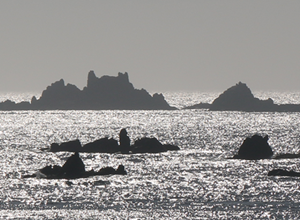Was Scilly the inspiration for Tennyson’s Land of Lyonesse, the site of Arthur’s final battle with his rival Mordred?
“Then rose the King and moved his host by night,
And ever pushed Sir Mordred, league by league,
Back to the sunset bound of Lvonesse-
A land of old upheaven from the abyss.
By fire, to sink into the abyss again;
Where fragments of forgotten peoples dwelt,
And the long mountains ended in a coast
Of ever-shifting sand, and far away.
The phantom circle of a moaning sea.”

Mythology says that Lyonesse lay off the coast of Cornwall. The Seven Stones rocks have been called the last, lonely hilltops of a long-drowned world. Fifteenth and sixteenth-century writers insisted that there were 140 churches submerged between Cornwall and Scilly, and there are stories that fishermen would catch pieces of doors or windows in their nets and on their fishing hooks around Seven Stones Rock. In Mount’s Bay, near Penzance, the remains of a submerged forest can be seen at low tide.
A parallel fable exists in Brittany, where the drowned city of Ys, in the Bay of Douarnenez, is said to have church bells which still ring when the sea is rough. The story goes that Ys, like Lyonesse, was destroyed by a flood with only one survivor riding a white horse.
We do know that 15,000 years ago, the lands off the coast of Cornwall would have been above sea level, and the sea level around Scilly has risen about 4 meters in the last 3000 years, with the South West of the UK slowly sinking.
There are signs of field walls on the sea bed off Samson that can still be seen at low tide.
